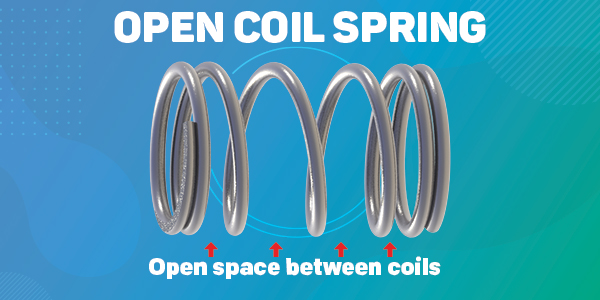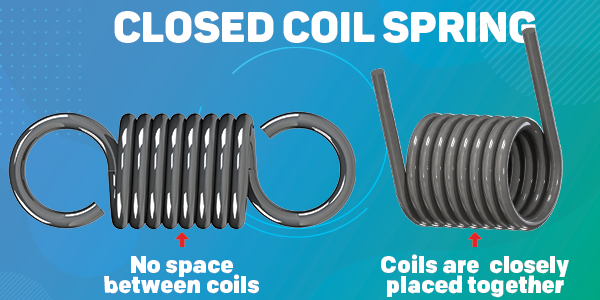Open Coil Springs and Closed Coil Springs Explained
You may have heard of open and closed ends on compression springs, we talk about it in detail here: Compression Spring End Types. Open and close ends are the terms for the ends and finishing touch on a compression spring. However, there is a similar term that we want to address today, that is not to be confused with this. The term open coil spring and closed coil spring, refers to the type of spring itself. So today we want to take a few moments to address what this means and the differences between an open and a closed coil spring, as well as ensure that there is no confusion between this and the types of ends on a compression spring.
Open Coil Springs
As the term states, ¨open coil¨ spring refers to all the active coils in the spring and the spacing between them. The open space in between the coils can also be referred to as pitch in spring manufacturing terminology. An open coil spring has open space (pitch) between the coils, compression springs are sometimes referred to as a: ¨open coil spring¨ due to this. The space between the coils in a compression spring allows it to store energy when it is compressed and release it as they decompress. That open space between the coils is what allows them to compact when force is placed on them and then bounce back when the force is released or removed.
Type of Ends in Open Coil Springs AKA Compression Springs
*Important Note:* The end types of a compression spring can be open or closed, they can be ground or not, they can be double closed or closed and square. To better understand the end types of a compression spring please review the information in this page: Compression Spring End Types.

Closed Coil Springs
The term, ¨closed coil springs¨ refers to extension or torsion springs in which all the coils are touching each other and are compacted one against the other. Since extension and tension springs have no open space between the coils, they are referred to as ¨closed coiled springs¨ and their function requires them to have the coils touching in their natural state so they can perform the function of pulling or twisting when forced is placed upon them.

Closed Coil Springs: Tension or Extension Springs
In the case of an extension spring (also known as a tension spring), the coils are close together because it is created to resist the pulling or stretching force, therefore it needs to create tension as it extends. Unlike compression springs, these springs usually have hooks attached to the ends so that the necessary force can be applied to one or both ends as the spring performs its function of resisting and pulling such force instead of pushing it.
Closed Coil Springs: Torsion Springs
Torsion springs, on the other hand, are also ¨closed coil springs¨ but they are not typically pulled, rather these have a twisting or torquing motion that is applied to them. These types of springs usually have legs instead of hooks. The legs create a type of anchor for the force to be applied in opposing directions of each end so the spring can torque.
Design and Buy Open or Closed Coil Springs At Acxess Spring
Whether you are looking for a closed or open coil helical spring, at Acxess spring we can assist you in the entire process. From designing to manufacturing and delivering it right to your doorstep. Contact us today at (951) 276-2777 and ask for one of our specialized coil spring design engineers.





